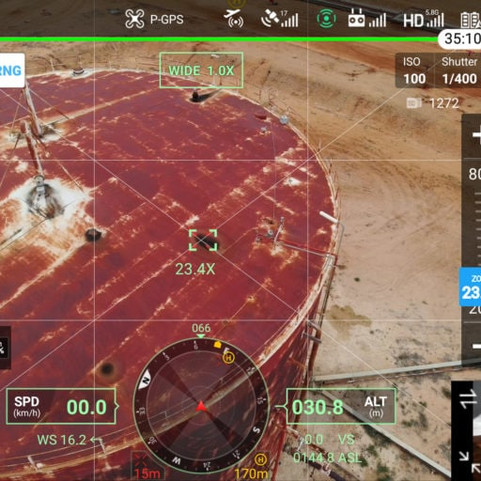A Wild West Adventure – Drone Inspections
- Tim Cheetham

- Mar 17, 2022
- 2 min read
We were contacted by an oil and gas company who were having some issues with their storage tank roofs. They were hoping we could use a drone with a combination of Infrared thermal imaging and a zoom lens to locate these defects and provide some data to help plan repairs. First we performed an initial job feasibility assessment, determined the job could be done safely and that we had the ability to collect the required data for the client. The Matrice 300 with H20T camera was the perfect tool for the job.

The only issue was the site was 1300km deep into south west Queensland. Normally contractors would be flown out to this site via Brisbane or Adelaide, but at the time, both of these locations were subject to COVID related quarantine periods. The other issue with air travel was even though we could fly to the location with our inspection drone as luggage, the drones batteries were so big they’re considered dangerous goods and must be transported by road freight. Road freight to this location could take up to two weeks there, and two weeks back. After much deliberation we decided it would be easier to drive ourselves out to site. That way all our equipment could remain in our travelling office, the trusty old Hilux. As any traveller would know, a lot of planning goes into road trips like this. The further you travel west, the towns get smaller, fewer, and further between, as do the fuel stations.
As we travelled, we watched the landscape change along with the flora and fauna. The roads got straighter and narrower, the earth got redder, the trees just about disappeared and eventually, we found ourselves in the outback. I kept expecting to drive past and old blue Ford F100 like Mick’s from the ‘Wolf Creek’ movies.

Eventually we got to site, checked into the camp and sorted out site inductions/work permits etc. We performed several flights, surveying each tank using both thermal and zoom cams as well as the laser range finder to locate and record exactly what the client was after.


After the final flight, we reviewed and backed up all the collected media, ensuring we had more than enough data to generate a thorough Inspection Report. After all, its a long drive back if we forgot something.
While we were on site, isolated showers dumped an unseasonal amount of water between us and the east coast. The trip back showed us another side of this outback landscape with standing water covering vast areas that previously looked like a desert. There was even water over the road in places, making us thankful more rain didn’t fall. Backtracking to find another road home could have added days to our trip.

A 70 page inspection report was generated, identifying all the issues found with the storage tanks. Not only were we able to display high resolution images of each defect and where they were located, but we could remotely measure each defect with millimetre accuracy, providing the client with useful information to plan repairs.
It really was an awesome adventure. We always enjoying flying the Matrice 300 for inspections like this. There is no better tool on the market with a camera combination of thermal imaging and optical zoom. The results speak for themselves.




























































Comments